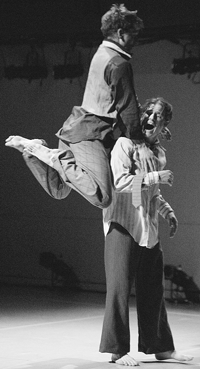A 20th anniversary season is capped by the intimacy of two dancers
By GUS SOLOMONS, JR.
David Dorfman looks like a tipsy businessman, cavorting joyfully at his daughter’s wedding.
A closer look, though, reveals that he’s actually doing really hard stuff with great control, enabling him to pull off the ostensibly reckless spontaneity.
His wonderful dancers––Paul Matteson, Heather McArdle, Jennifer Nugent, and Joseph Poulson, and guests Shani Collins, Tzveta Kassabova and Francis Stansky––also capture his zany abandon, as they hurl their resilient selves through Dorfman’s action-packed choreography.
Celebrating its 20th anniversary at the Joyce Theater, April 31 through June 5, David Dorfman Dance reprised last year’s “Lightbulb Theory” and premiered “Older Testaments” for six dancers and a new duet, “approaching some calm,” for him and his wife, Lisa Race––all with live music.
“Lightbulb Theory” opens with an extended prologue for Dorfman. Wearing a dark overcoat and culottes––his customary garb––he runs through his movement lexicon, energetic bursts, leg whips, twisting hops that defy stylistic categorization. The solo concludes with Dorfman’s reading a poetic memorial to his deceased father.
Then, a knot of light bulbs hanging overhead bursts into a swinging spray of stars––lighting was by Josh Epstein––and Matteson, McArdle, Nugent, Poulson and Kassabova, dressed in sporty casual clothes by McArdle in collaboration with Adele Twig, dance a syncopated jig that recurs throughout the dance in myriad variations.
Composer Michael Wall at the piano plunks out delicate melodic fragments on the keys and the strings inside. The dancers whoop and holler as they dance, like cheerleaders at a varsity game. The final section of the 30-minute dance begins with a solo for Nugent, and then the dancing meanders at length through Wall’s wittily minimalist rendition of “Moon River.”
In the new work, “Older Testaments,” Matteson in a long black coat looks rabbinical, standing inside a three-sided, transparent box on wheels, while his congregation of five mills around amidst columns of stacked books and others strewn on the ground––presumably Bibles––and Middle Eastern script is projected across the cyclorama. Kris Stone designed the set.
Jane Cox’s animated lighting turns the stage sunny and mysterious by turns. In the pit, five able musicians––Ron Caswell (tuba), Dana Leong (trombone), Matt Moran (drums, percussion), Brandon Seabrook (guitar, banjo) join composer Frank London (trumpet), playing his klezmer-like score.
Onstage, the six dancers cram into the box and introduce themselves to each other as “Dick––from the Bible” (“There are a lot of Dicks in the Bible,” someone deadpans.) and “Jane—from the Bible.” Matteson and McArdle remove their black coats and, wearing chic, earth-toned costumes by Naoko Nagata, dance a duet of colliding lifts and leverages that show off the best of Dorfman’s considerable physical invention. Bodies connect in constantly surprising ways; Matteson swings McArdle over his back, and then she reciprocates with him, or he grabs a leg and yanks her backwards onto his shoulder.
A complexly modulated passage of vigorous movement for the group contrasts London’s woozy tempos. Then piece by piece, the dancers strip off their clothes and crawl passively towards the box, which has been transformed into a house, until everyone is again crowded inside, milling slowly around—naked. Are they meant to represent innocents of Eden or gulag inmates, unaware of their impending doom? The image is rife with provocative connotations.
What keeps these smartly made, funny, compassionate dances from smacking you harder in the heart is the notion that Dorfman’s sensibilities seem stuck in the ’80s, when he founded his 20-year-old company. The dances get mired in excessive movement repetition and illustrative text:; everything goes on too long. Both of the ensemble dances also suffer from the choreographer’s failure to decide whether they’re narrative or abstract.
The one piece on the program that neatly resolves the dichotomy between storytelling and pure dance is the tender, concise autobiographical duet “approaching some calm” for Dorfman and Race that consists of a series of bumptious episodes. Repeatedly, Dorfman raises his arms and wiggles his fingers, like rain falling; Race braces herself on his back in a handstand and then they collapse to the ground. She dances in place, while he runs around her; she stands on him and rolls him like a log.
Klezmer master Guy Klucevsek on accordion, accompanies them with his whimsically deconstructed arrangements of Burt Bacharach titles like “Raindrops Keep Fallin’ on my Head,” “This Guy’s in Love With You” and “Wives and Lovers,” songs that relate to the Dorfman/Race real-life partnership. The couple ends the dance in a loving heap, his wiggling fingers slowly wrapping her in a gentle embrace. Their palpable enjoyment of dancing with each other is touching, and our enjoyment of their intimacy is moving.
gaycitynews.com

































